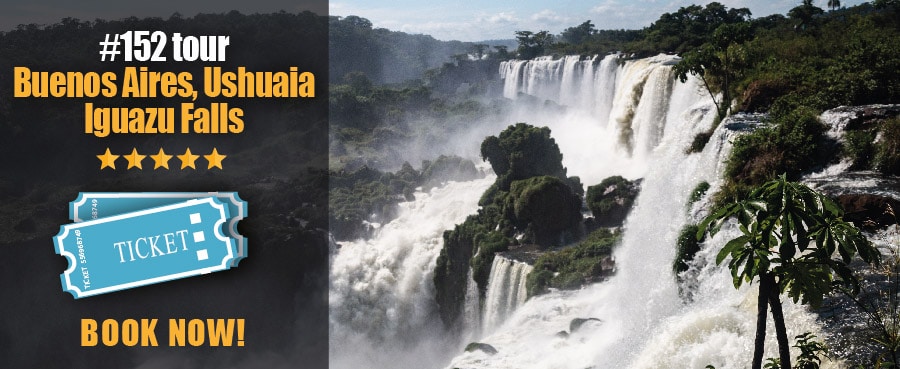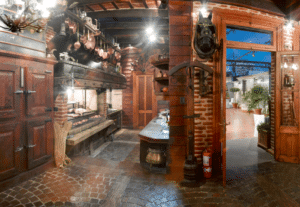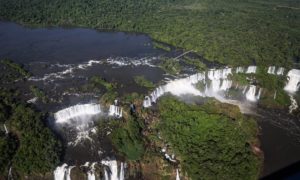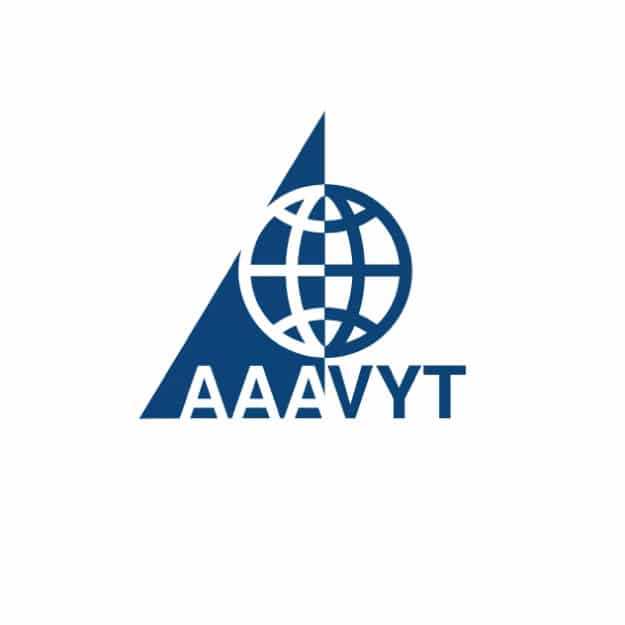Ushuaia, is the southernmost city in the world, and a fascinating place to visit when you decide to go to Patagonia. In the following words, I tried to explain my experiences visiting this amazing city in Tierra del Fuego Island:
DAY ONE: Arrival to the south of the world
The plane shook a bit, when I looked out through the plane’s window, I saw the reason. We were crossing the Andes mountain range, which in Tierra del Fuego, the southernmost portion of Argentina (if we do not take into account Antarctica) extends from west to east. Indeed, Ushuaia is the only trans-Andean city in the Argentine Republic, something that makes this beautiful city unique. But it is not only for this reason that Ushuaia is different. It is also the southernmost city in the world. Yes, this city is located in the south coast of Tierra del Fuego Island, part of the archipelago with the same name. For lovers of accuracy and geography, Ushuaia is located 54 ° 48′26 ″ S 68 ° 18′16 ″ W.
The plane turned right, and the view of the Beagle Channel appeared in the front, with the view of the east coast in my right window. It is a sparsely inhabited coast, but with a long history when the first navigators visited for the first time, these unexplored lands for the Europeans. They were occupied by the aborigines of the area who were perfectly adapted to the demanding climate of the region. The plane landed on time, and when leaving, the first thing that caught my attention was a steep mountain, an example of what a perfect mountain should be. It is Mount Olivia, with 1,326 meters above sea level, and located very close to the coast. The attention of the staff that received me was very good, and the weather was friendly. Only 15 degrees Celcius, a good temperature for February. The lights began to appear on the city that was unfolding in the distance and climbed the mountain. It was almost ten o’clock at night, the daylight stretches for many hours during the summer, allowing many activities.
I booked a hotel called Arakur, located on the Alarken hill, with an incredible view of the city, and surrounded by a provincial reserve full of green trees and natural life. The spa remains open until midnight, so after leaving my stuff in the room, I had time to visit it. It´s huge and amazing. The view is unique, and they offer a very big indoor pool and one indoor/outdoor pool with jacuzzies. I was lucky to contemplate an unforgettable sunset with the Beagle Channel, the city, and the Andes as a backdrop. I went to sleep after a cup of coffee, because the next day my first excursion was programmed from 7:30 am.
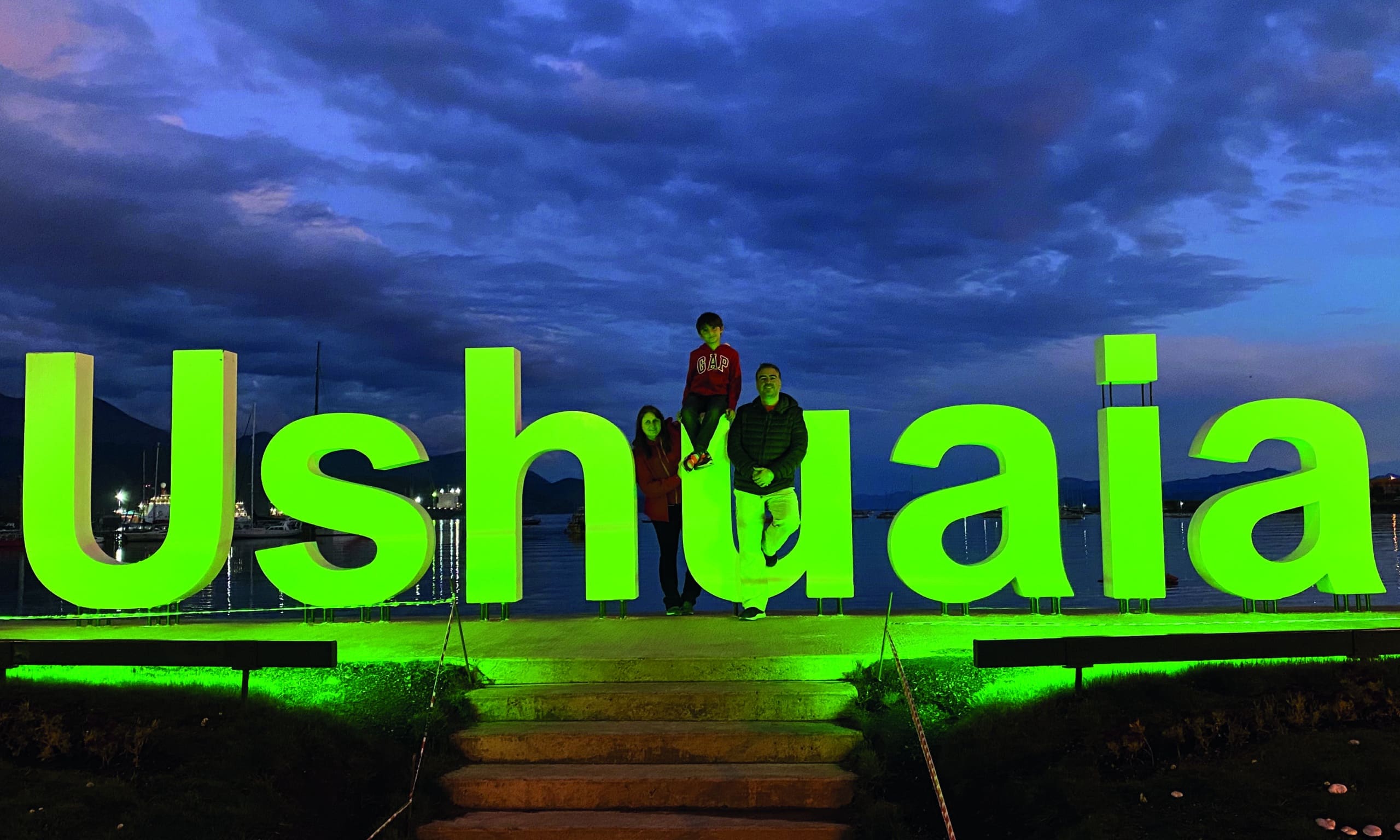
DAY TWO: Beagle Channel Navigation, penguins and history
The sun woke me up very early. Sun appears around 5:30 am in Ushuaia during the summer. When I went downstairs for my breakfast, I found a wonderful buffet in a fantastic room with large windows that overlooks the Beagle Channel and the city of Ushuaia. The day was clear. I served a slice of salmon and my classic scrambled eggs, a cup of english breakfast tea, and got ready to observe the scenery. Behind the hotel stretched a beautiful green forest, which is part of the Alarken Provincial Reserve, which I promised to visit later. I drunk the last sip of tea and be ready to wait for the driver who would take me to the pier, in the heart of the city, to board the catamaran that would take me to navigate the Beagle Channel, and visit different attractions. Marcos, that was the driver’s name, was a 44-year-old man, who got bored with life in the big city and decided in his thirties, to move to the end of the world and start a new life.
– I am happy here, when I travel to Buenos Aires, it is very difficult for me to stay there. I’m thinking of going back soon. You know, I love the peaceful and quiet life of Ushuaia.
Indeed, Ushuaia is a small city of almost 60,000 inhabitants (although the 2020 census is expected to indicate that there are many more). Is a city with a calm rhythm, but with a very important port, full of cruises that stop in this mythical city, to continue towards the Malvinas Islands, Punta Arenas, or Antarctica. Ushuaia is also the gateway for many of these cruises that visit Antarctica between the months of November and February or March. I paid to Marcos who wished me luck. I spotted my boat in the distance and took a great photo of the port and its ships at the dock. The catamaran was very comfortable. I chose a location near the exit, to be able to go outside and take photographs. Of course, the Beagle Channel is full of islets, history, and animal life. Remember that Argentina and Chile almost came to war in the dispute over some islands located there. This occurred in the late 1970s, which ended when the Pope, Juan Pablo II agreed to mediate between the two countries, preventing the start of the war.
Regarding animal life in the Beagle Channel, let me say that it is very varied. On the Island of the Birds (Isla de Los Pájaros), an islet within the Beagle Channel, I could see a large number of seabirds. There you can find petrels, southern gulls, cooking gulls, imperial cormorants, Pacific steam ducks, sea gullies, southern oystercatchers, and perhaps some Magellanic penguins. In the distance, these birds appear to be penguins, but they are not. Penguins are deeper into the channel, on an island that I would visit later. The second stop was on the Isla de Los Lobos, named for having one and two-haired sea lion specimens. I took some pictures, and I saw the sky. The weather begin to change again. Some clouds crowded rapidly, threatening rain. It is that the climate in Patagonia is very variable, and can go from full sun to rain in the blink of an eye. El Faro Les Eclaireurs or Les Eclaireurs Lighthouse, was the next stop. It is a lighthouse located on islets that have the same name, it was named by Captain Frigate Luis Fernando Martial, in command of the French expedition La Romanche in the years 1882-1883. It is a lighthouse made of bricks, painted red and white that many confuse with the Lighthouse at the End of the World, although the eponymous novel, written by Jules Verne, was inspired by the Lighthouse San Juan de Salvamento, located on the Isla de los Estados, also Argentine territory. I took some fantastic photographs of this desolate spot in southern Argentina. Without a doubt, one of the postcards of Ushuaia.
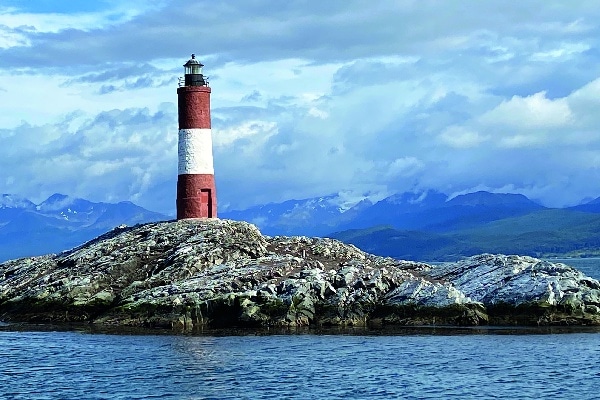
The ship continued to sailing east. The rain started now, combined with the cold south wind. The guide announced one more hour of sailing until reache Isla Martillo, home to an interesting penguin colony. So I prepared to have a coffee while sitting, looking at the landscape, imagining what those times were when life there would have been difficult. On the opposite bank, a small population breaks through history. It is Puerto Williams, a small town that grows day by day on the Chilean bank of the canal. Just at that time, the guide took the opportunity to deepen the Beagle conflict that was a disagreement between the Argentine Republic and the Republic of Chile on the determination of the trace of the eastern mouth of the Beagle channel, which affected the sovereignty of the islands located within and to the south of the channel, and to the east of the meridian of Cape Horn and its adjacent maritime spaces. And these two countries almost went to war, although the last-minute political decision of the Argentine Military Junta to accept the Vatican intervention avoided the war and led to mediation that led to the signing of the Treaty of Peace and Friendship on November 29, 1984, which resolved the conflict after more than two-thirds of a century of dispute.
Finally, the boat approached Martillo Island. As it is a catamaran, the boat faced the island to almost run aground on it, which allows us to closely observe the colony without descending from the boat. The experience was very good because the colony is very interesting. Martillo Island is home to a remarkable penguin colony. The dominant species here is the Patagonian or Magellanic Penguin (Spheniscus magellanicus), and is the colony of this southernmost species in Argentina. The number of reproductive couples of the Martillo Island year after year has been in permanent increase, with more than two thousand nests in 2005. On this island, the specimens of this species begin to arrive in September. The males return earlier, to start acquiring and defending their nests. It is estimated that the number of laying is two eggs on average, and the period in which they hatch is approximately 40 days, a task performed by both parents, alternately. Chicks begin to hatch, usually between the first and third week of November, and are fed by both parents for 70 to 100 days. But what makes the Martillo Island penguin colony relevant is the fact that it possesses the only reproductive colony in the South American territory of another penguin species, the Papua (Pygoscelis Papua), represented by the subspecies that inhabits that subcontinent, the subantarctic papua penguin ( Pygoscelis Papua Papua).
In recent times it is also possible to see a couple of King Penguins, a species that is usually seen further south, but that seems to want to bet there too. Of course, I took the opportunity to take many pictures of the colony.

After 20 minutes of enjoying this colony, the catamaran went to the coast located in front of the island, to arrive at Harberton Ranch, a place with a rich history. After disembarkation, a young lady was waiting for us. The rain stopped and again, we have a sky with the sun mixed with some grey clouds. The lady explained that Harberton Ranch is the oldest in the Argentine sector of Tierra del Fuego. The founder, Thomas Bridges, was an orphan found on a bridge in England, who was later adopted by an Anglican missionary, the Rev. G. P. Despard. In 1856, at the age of 13, he was taken with his adoptive family to Keppel Island (Watcher) in the Falkland Islands, where a mission was being installed. There, he learned the Yahgan language, the language of the Yámana canoeists in southern Tierra del Fuego, who were taken to the Malvinas for training. During his first trip to Tierra del Fuego, in 1863, he was able to speak to the Fuegians and explain the mission’s objective. He founded the Anglican Mission in Ushuaia in 1870, settling permanently with his wife, Mary Ann Varder, and their young daughter Mary, in 1871. In 1884, he received the first Argentine expedition to Tierra del Fuego, in which the sub-prefecture was established in Ushuaia. Two years later, after thirty years with the Keppel and Ushuaia missions, Bridges receives Argentine citizenship and a land donation from the National Congress, in recognition of President Julio A. Roca for his work with the natives and shipwrecked in the Cape Horn region. The ranch he founded, firstly called Downeast, is located 40 nautical miles (60 km) east of Ushuaia. It was named Harberton because of his wife’s place of origin, in Devon, England, and it was the first production company in Tierra del Fuego. Today, the ranch belongs to the grandchildren of Will and Lucas, sons of Thomas Bridges. Its administrator, Thomas D. Goodall, is the fourth generation (great-grandson) of the founder and lives in the ranch with his family (members of the fifth and sixth generation), in the original house built in 1887. Declared a National Historic Monument in 1999, the estancia maintains its original architecture, with wooden buildings covered with corrugated metal, its gardens, piers, and stone terraces. Originally operating with sheep (for wool) and cattle (for meat), Harberton also had the first warehouse and imported merchandise for all of southern Tierra del Fuego, also selling vegetables, meat, and supplies to the miners of the time. There are many books and articles on the Bridges family and Tierra del Fuego, but the undeniable classic is still “The Last End of the Earth”, written by E. Lucas Bridges, son of the founder. His story was chosen by the New York Explorer’s Club as one of the hundred best explorer narratives of the 20th century.
There is no doubt that the visit to Estancia Harberton is very interesting because it helps to have a clearer idea of how difficult life was in those remote lands, and of the political importance that Mr Bridge’s task has had for Argentina, populating those lands. Of course, I had time to taste an exquisite lentil stew, with lamb meat. An ideal dish to enjoy that gray afternoon again. In the distance, the wind is visible on the surface of the Beagle. I will have time for a coffee and for my last walk over those lands.
The return was by land, the vehicle dropped me at the Hotel Arakur. It was about seven in the afternoon. A break in the spa seemed ideal and I did it. They have a very good bar service, so it was possible to enjoy a good glass of white wine inside the jacuzzi, while I observed the last lights of that day. A deluxe service¡ As I already told you, that spa is fascinating. The contrast of the cold weather with the heat of the heated water is something that I enjoy a lot. I got ready to dive in and oh surprise! there is music underwater!
I relaxed until midnight after having a light dinner. I took a good bath and went to bed. The Tierra del Fuego National Park and the famous End of the World Train will be waiting for me tomorrow.
DAY THREE: Tierra del Fuego National Park and the Train of the End of the World
The guide was waiting for me in the hotel lobby when I finished finishing my breakfast. Complete as I have told you, with a wide variety of homemade sweets and various bread. The day was similar to yesterday, with some clouds mixed with the blue sky. It is important to know that in this part of Patagonia, the ozone layer is not as strong as in the rest of the planet, so it is not a bad idea to wear a cap and some sunscreen. My destination was Tierra del Fuego National Park, located just 12 km from the city, so the journey is fast. It is a national park that protects a portion of the southern end of the Andes mountain range, Fuegian forests, glacial lakes, and marine coasts with biodiversity belonging to the marine ecoregion called Channels and Fjords of southern Chile. It has been determined that the area was occupied by hunter-gatherers of the ethnic groups such as the canoe yámana or yagán, and the selknam (also known as onas). Cumulus clouds with the remains of mussels and other mollusks and crustaceans they fed on can be found throughout the area. As soon as we arrived, the first stop was the End of the World Train station, head of the southernmost railway in the world. This alone makes the visit a must, although the historical value is also very important, and has bases in the origin of the city of Ushuaia that we know today.
At the End of the World station, head of the train of the same name, many people waited for their ticket. Fortunately, our guide Eduardo had already acquired them, so it was much faster. I had assigned train number three, and people were still queuing to board number two, so I had some time to tour the station. A large glazed window separates the waiting hall from a workshop, where parts of this famous train are repaired.
They will tell us more about the history, but it is important to know that after forty years without working, in 1994 the End of the World Train resumed part of the old route that the prisoners’ train used to take, which started from the Ushuaia prison, located in the center of the city, towards the slope of Monte Susana with the aim of obtaining materials (wood and stone) for its construction.
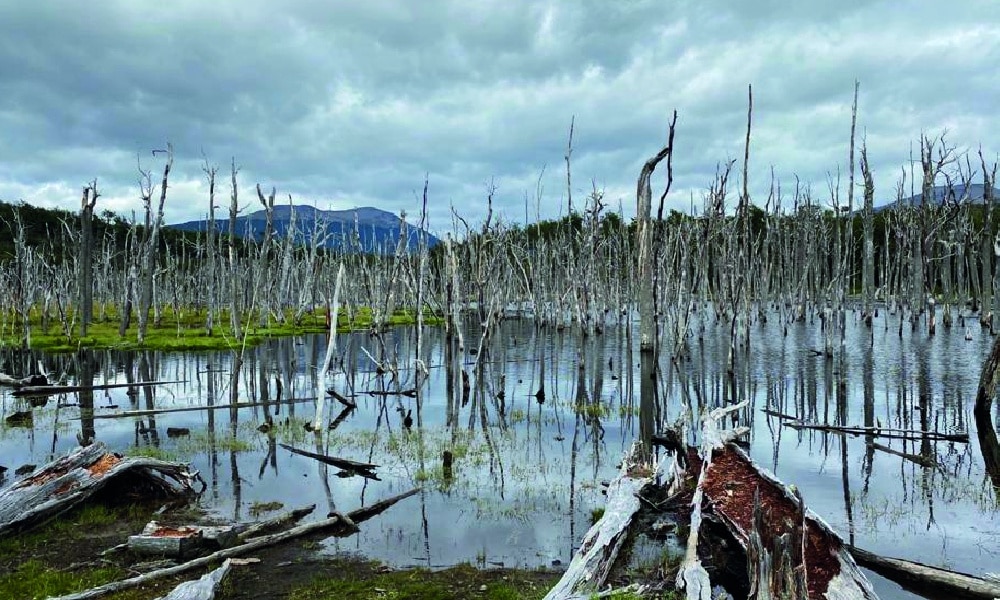
A beautiful young woman approached and changed the sign indicating the train number to board. It was number three. From the platform, I could see the tiny of those narrow gauge wagons, impeccably maintained, and with the wonderful forest in the background that gave frame. The locomotive announced the departure with three loud whistles, and we headed towards the bowels of the national park, full of history and beautiful landscapes. Already on board the train one can hear the story of the prisoners who came to cut wood to this area daily. I was able to enjoy the magnificent landscapes, made up of the zigzagging Pipo river, the La Macarena waterfall, the tree cemetery, and the majestic Lenga forest. The train made up of a steam locomotive, and its elegant cars have large windows and an individual audio system, which offers the possibility of listening to the story in 7 different languages, in order to not only appreciate the nature that surrounds it but also to know a very important part of the history of Ushuaia. I imagine life in those times, with the hostile climate and hard work in that remote area.
The locomotive whistled again, to announce the first stop on the route. It was La Macarena Station, a place of historical interest where the prisoners’ train used to stop to provide water to the tanks of the steam locomotive that has a name, it was called La Coqueta. At this stop, it is possible to ascend to a viewpoint that offers an unbeatable view of the Pipo River Valley, Cerro Guanaco, Cerro la Portada, and Mount Susana. Ascending towards the top, it will be possible to arrive at the source of the La Macarena waterfall in the Le Martial Mountain Range, which is formed by melting ice that is born at the top of said mountain. The day was ideal, full sun, although the cold was noticeable in the shade cast by some taller trees. Two people disguised as prisoners offered me a photo, and I agreed. After almost half an hour, and enjoy a fascinating view of the valley, the train, and nature, the locomotive whistled once more to call us back. The train restarted his march to the edge of the national park first, and the tree graveyard later. Indeed, bordering the Pipo River, I could see the traces of the prisoners’ daily routine after almost half a century of cutting down forests to supply the town with firewood. This is a place where you can really appreciate in its entirety the daily work of the prisoners. The remains of logs that do not exceed 50 cm in height above the surface are undoubtedly a sample stopped in the time of the work carried out by those men. I was also able to observe a type of Fuegian ecosystem called peatland. It is a type of soil characteristic of Tierra del Fuego that is composed of compacted organic and mineral material that is given many uses and is a very important reservoir of water. Finally, the train approaches the last point of my journey. It is the National Park Station, where Eduardo awaits us to continue the tour. Although it is possible to return by train to the point of origin, the idea is to continue the visit to reach other interesting destinations within the park.
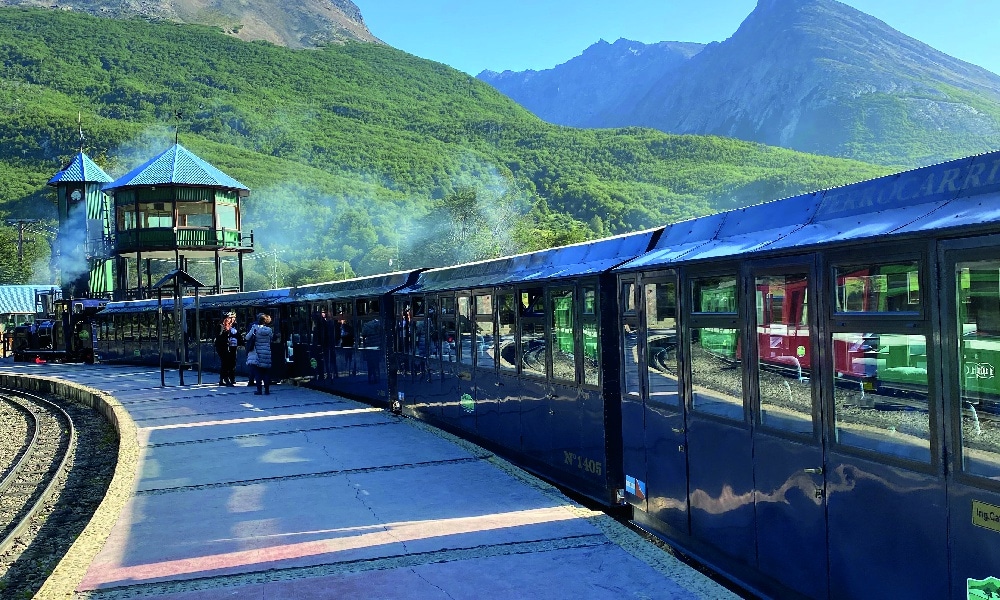
The National Park was created in 1960, but in 1990 most of it was used as a protected reserve. Of the total of 63,000 hectares that make up the park, only an area of 2,000 is assigned for tourist use, the rest having the category of the strict nature reserve. On the bus, Eduardo told us about the fauna and flora of the place. As in many of these southern Andean forests, lenga and ñire predominate in the place and dye everything green. Of course, if you travel in the autumn months, the landscape will turn reddish, and if it is in winter you will see it covered in snow. Tierra del Fuego is different all year round. Various animals live in the area, such as the fox, the guanaco, the incredible Andean condor, and a great diversity of birds and insects. During the 20th century, specimens of fauna from the northern hemisphere, such as muskrat, rabbit, and American beaver, were introduced to the island and have been acclimatized in an excellent way; the last two species cause serious disturbances in this national park. The Beaver was brought in to develop a strong furrier industry, but some factors did not allow it to be a success. The cold is not as cruel as in the northern hemisphere, with which the Beaver’s coat did not have the necessary quality, so the idea was abandoned sometime later, with the terrible idea of freeing the pairs of beavers, which reproduced quickly, causing a lot of damage to the flora of the park. The introduction of exotic trout was extremely detrimental to native fish as well, which were preyed upon by these species. The lakes and lagoons of the park have a remarkable salmonid population. The most important species is rainbow trout, which is why sport fishing is also an interesting attraction for lovers of this activity, which is strictly regulated within the park.
The bus stopped in front of a large lake. Before going down to take some photos, Eduardo told us that it was a lake of glacial origin, which is located in a longitudinal northwest-southeast direction, between the Guanaco mountain ranges and the Pyramids of the Andes mountain range. Its length is approximately 11 km, with an average width of 1.5 km, locating two-thirds of its extension in Chilean territory. The lake is the result of the natural embalming of the Lapataia river, a product of a glacial moraine. The Argentine part of its basin is fully protected by the Tierra del Fuego National Park. The Chilean part is fully protected by the Yendegaia National Park.
In reality, the lake is called Roca, in the Argentine sector, while that of Errázuriz corresponds to the Chilean sector. These two names come from the surnames of the presidents Julio Argentino Roca (from Argentina) and Federico Errázuriz Echaurren (from Chile) who starred in the Embrace of the Strait on February 15, 1899 aboard the cruise ship O’Higgins, ending the Litigation of the Puna de Atacama. I think the names are correct, although Eduardo made me think otherwise. The aboriginal name of the lake is Acigami, which in the Yagan language means “basket or long bag”. It seemed the fairest thing to me, to give the lake its original name, something that has been restored in 2008, in the Argentine part, by the National Parks Administration. A wind had blown up, blowing from the bottom of the lake, forming some waves. There was no doubt that he was in a remote place in the heart of Patagonia. I took several pictures, before taking a few minutes sitting on a log, enjoying that unique landscape and the icy wind on my face. The guide looked at me, almost like inviting me to get on the bus, and I did so. We still had the visit of Bahia Lapataia.
This will be the last point of our visit and one end of the national park. Upon arrival, a sign indicates that it is the last point on National Route Number 3, which begins in Buenos Aires and ends there, after 3079 km of travel. A path allows to cross the area and to have a view of the Beagle Channel and a small port where some boats arrive. Indeed, it is also possible to reach the park by sea. Etymologically, Lapataia comes from the Yagan language, and means “forest bay” or “wood bay.” Hunters, shellfish gatherers, and gatherers, of the Yámanas or Yagan ethnic groups, occupied its coasts, exploiting its biological resources. The clusters with the remains of the ashes, bones, and teeth of marine mammals, and mussel shells that they fed on are still perfectly visible in the first hills near their beaches, covered by vegetation, although the caves of the introduced European rabbits they have affected them a lot, according to Eduardo. These clusters are locally called anthropogenic shells or shells. Finally, I returned to the bus, my watch showed 1:00 pm, and the idea of returning to Ushuaia and tasting one of the two typical dishes that I promised to taste in the area, came to my mind. I imagined it was time to try the famous Fuegian Spider Crab.
After the delicious dish of spider crab parmesan, I started to walk down Mitre Street, crossing the center of the city. It is a small city, but it has grown a lot in recent years. It is full of shops, souvenir sales, restaurants, and free shops. It should be remembered that Ushuaia is exempt from the payment of some tariffs, which makes some items cheaper than in the rest of the country. My intention is to reach the other end of the main street, where the Ushuaia Maritime and Prison Museum is located. That’s right, the old prison in the city, where it all started, to complete the visit that began this morning with the End of the World Train. Of course, the Maritime Museum is very important and interesting because the history of sailors in the area is very rich. It is a museum full of stories of shipwrecks in Cape Horn, the Island of States, the End of the World Lighthouse, delves into the importance of the Yamana Canoe, and informs about Antarctica and its explorers. Also present are the fauna, the history of the gold diggers, the yaganes, and the expeditions and investigations currently underway. All this within a very significant building that is the Former Presidio of Ushuaia or the Tierra del Fuego Prison.
It is interesting, because with a maritime theme it touches everything related to the history of Tierra del Fuego from the special point of view of the man of the sea since the island of Tierra del Fuego and the archipelago that surrounds it, in addition to the Falkland Islands, the Georgian Islands and Antarctica are linked to the sea in all concepts and throughout history. But of course, the most recent history is based on the prison, and on the establishment of those prisoners in what would later be the city of Ushuaia. It is interesting to walk through the narrow corridors and look into the cells to imagine what life in prison would have been like. The cold is still felt within its walls. Here, the most dangerous convicts in the country lost their names by a number, and only dedicate themselves to work. It was impossible to escape there and survive. Going through the gates of the historical Pavilion is taking a step back in time. Some convicts achieved great notoriety such as the multiple murderers Mateo Banks whom they called “the mystic” or Cayetano Santos Godino is sadly known as “the petiso orejudo” and the anarchist Simón Radowitsky. Behind the doors, severe discipline was imposed, although those with good behavior did jobs outside the building, such as logging in the woods that came by train from the city center. Through the workshops, the prisoners met all the needs of the incipient city: they built the streets, bridges, and public buildings and the first printing press, telephone, electricity, among other essential services, working in the prison.

It was barely three-thirty in the afternoon, and they had told me very well about a hike that could be done to approach the Martial glacier. So I took a taxi to get after ten minutes to the base from where that walk started. There are services and a very interesting tea house, with souvenirs and very good pastry. From this point, I walked along a path that continues to ascend to the base of the Glacier to enjoy beautiful panoramic views of the city and the Beagle Channel. Beyond the glacier, you cannot continue without special equipment and guidance. It is a tour that takes no more than forty minutes and can be done quietly in a while. Going down, accompanied by the incessant sound of the melting waters, I prepared to drink a cup of tea, the best blend I have tried lately, with a touch of peaches and black and white tea. The days in Ushuaia are long, and I still had time to return to the city and dine on another typical dish from these lands: El Cordero Fueguino.
And there are many restaurants where you can eat a good Fuegian lamb. Consisting of lamb, roasted on a cross, typical shapes used in many regions of Argentina, cooked over low heat. I must say, I have rarely eaten any meat as exquisite as that night. They say that the secret is that those sheep walk a lot in search of food. Indeed, the fields of Patagonia require that the animals move a lot in search of food. I don’t know if it will be the real reason, but I must say that it was a fantastic dish. I got ready to go back to the hotel, and abandon myself in an armchair in front of those large windows that Arakur offers on the Alarken hill. The city lights went on and soon, I realized that my time in the lands of the End of the World had come to an end. For me, it had been a wonderful experience. A new sunset, unforgettable like the previous ones. A glass of wine and go to bed. Ushuaia and Tierra del Fuego had fulfilled their objective. I had fallen in love forever.
Tours visiting Ushuaia
We have many tours to visit Ushuaia. Of course Ushuaia only, and combined with different destinations in Argentina and Chile. One of them is our 152 tour: Buenos Aires, Ushuaia and Iguazu Falls, to discover Argentina in 10 days.
More tours to visit Ushuaia and Argentina
If you want a complete list of tours to visit Argentina, please click here or in the image below:
If you want to contact me, just email me at info@ripioturismo.com
Thank you!




